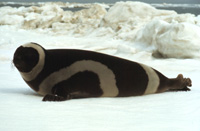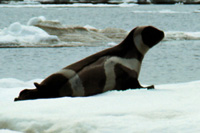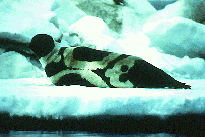Ribbon Seal
(Phoca fasciata)
IUCN STATUS (2010) - DATA DEFICIENT
| Distribution and Numbers The ice-breeding ribbon seal inhabits the north Pacific Ocean and the adjacent fringes of the Arctic Ocean, mostly in the Bering and Okhotsk Seas but also seasonally in the Chukchi Sea, western Beaufort Sea and northern Sea of Japan. One wandering ribbon seal was reported from California. Very little research has been carried out on the species due to its remoteness, and there is no reliable up-to-date count of the ribbon seal population. However a total estimate of 240,000 was made in the mid-1970s and, more recently, an estimate of 100,000 - 110,000 seals has been made for the Bering Sea population. The species is referred to by some scientists as Histriophoca fasciata. |
 Photo: Kathy Frost, Alaska Department of Fish and Game |
| Status There is a possibility that ribbon seals, like other Arctic seals, may be affected by changes in the climate, such as global warming, that could potentially alter the ice distribution in the region. Ribbon seals may also be affected to some extent by commercial fishing in the Bering Sea, as well as by disturbance from activities such as oil and gas exploration and extraction. |
| It is estimated that fewer than 100 ribbon seals are killed each year by Alaskan natives for subsistence purposes but this estimate is unreliable and the actual figure may be higher. From the 1950s to the 1980s Russian commercial sealing vessels killed between 6,500 - 23,000 ribbon seals each year for their pelts, oil and meat in the Okhotsk and Bering Seas. Commercial hunting of ribbon seals on the high seas has however largely stopped since the break-up of the Soviet Union. There is a small bycatch of ribbon seals in north Pacific trawl fisheries. |
 Photo: Kathy Frost, Alaska Department of Fish and Game |
Lifestyle Ribbon seals haul out mostly on pack ice, usually far from the shore where cracks and leads are available. In winter and spring they are found at the ice front in the Bering and Okhotsk Seas, but their distribution and movements at other times of the year are poorly known. Some seals move further north with the receding ice front in May to mid-July and have been observed in the Chukchi and Beaufort Seas. It has been suggested however that most of the seals, including those from the Okhotsk Sea, become pelagic near the edge of the continental shelf in summer and autumn. |
| Pupping and mating take place on the ice in the spring. Pups are born in April and May with a fluffy white coat which is replaced 3-6 weeks later by a blue-grey coat that is silver-grey on the front. Pups are weaned after a 3-4 week nursing period during which the mother occasionally feeds. Mating takes place from late April to early May but no details are known of the species' mating strategy. Adults moult in May to July, juveniles usually earlier. The coloration of the adult ribbon seal is very distinctive with four white, sometimes yellow-tinted, 10-12cm wide strips or ribbons around the neck, rear half and foreflippers of the seal. The ribbon seal's background fur is brown to black, the female usually possessing a lighter colour fur and less distinct strips. Immature seals have a grey background with light bands that become more distinct with age. |
| Regional differences exist in the prey of ribbon seals. However groundfish and shrimp are known to be major prey, and the species is also known to eat squid, eelpout, herring, halibut, capelin, cod and some crustaceans. Young ribbon seals have been reported as feeding mainly on crustaceans. Predators of the ribbon seal include the killer whale, Greenland shark and polar bear. |
| Statistics Adult ribbon seals of both sexes measure an average 1.6m (maximum 1.9m) in length, and weigh an average 70-80kg (maximum 148kg). Pups weigh about 9-10kg and measure 80-90cm at birth. Natural mortality during the first year of life has been calculated at 44%. Females reach sexual maturity at 2-5 years, males at 3-6 years. Ribbon seals probably dive to depths of up to 200m in search of food. Individuals can live up to 20-25 years of age. |
 Photo: Lew Consiglieri, National Marine Mammal Laboratory |
